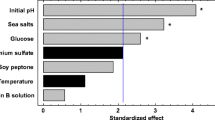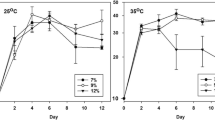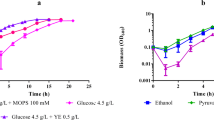Abstract
The growth, lipid content, and fatty acid composition of Aurantiochytrium sp. strain mh0186 at different temperatures were investigated. Strain mh0186 grew well at 15–30°C, but weakly at 10°C. The biomass at 15–30°C was significantly higher than at 10 and 35°C, and the total lipid at 15–35°C was significantly higher than that at 10°C. The amount of DHA in the total fatty acid was highest at 10°C and decreased in response to temperature increase. The content of DHA (mg/g-dry cell weight) at 15–30°C were significantly higher than those at 35°C and those at 15–25°C were significantly higher than those at 10 and 35°C. The DHA yield at 15–35°C was significantly higher than those at 10 and 35°C. Unsaturation of fatty acid was regulated by temperature and was enhanced in response to temperature decrease. The ratio of DHA to DPA varied at different temperatures.




Similar content being viewed by others
References
Ashford A, Barclay WR, Weaver CA, Giddings TH, Zeller S (2000) Electron microscopy may reveal structure of docosahexaenoic acid-rich oil within Schizochytrium sp. Lipids 35:1377–1386
Bajpai P, Bajpai PK, Ward OP (1991a) Production of docosahexaenoic acid by Thraustochytrium aureum. Appl Microbiol Biotechnol 35:706–710
Bajpai PK, Bajpai P, Ward OP (1991b) Optimization of production of docosahexaenoic acid (DHA) by Thraustochytrium aureum ATCC 34304. J Am Oil Chem 68:509–514
Bazan NG, Reddy TS, Bazan HEP, Birkle DL (1986) Metabolism of arachidonic and docosahexaenoic acids in the retina. Prog Lipid Res 25:595–606
Chihib NE, Tierny Y, Mary P, Hornez JP (2005) Adaptational changes in cellular fatty acid branching and unsaturation of Aeromonas species as a response to growth temperature and salinity. Int J Food Microbiol 102:113–119
Fan KW, Chen F, Jones EBG, Vrijmoed LLP (2001) Eicosapentaenoic and docosahexaenoic acids production by and okara-utilizing potential of thraustochytrids. J Ind Microbiol Biotech 27:199–202
Folch J, Ascoli I, Lees M, Meath JA, Lebaron N (1951) Preparation of lipid extracts from brain tissue. J Biol Chem 195:833–841
Gombos Z, Kanervo E, Tsvetkova N, Sakamoto T, Aro EM, Murata N (1997) Genetic enhancement of the ability to tolerate photoinhibition by introduction of unsaturated bonds into membrane glycerolipids. Plant Physiol 115:551–559
Hayashi M, Matsumoto R, Yoshimatsu T, Tanaka S, Shimizu S (2002) Isolation of highly DHA-accumulated Labyrinthulales and their utilization for nutritional enrichment of rotifers and Artemia. Nippon Suisan Gakkaishi 68:674–678
Hazel JR (1995) Thermal adaptation in biological membranes: is homeoviscus adaptation the explanation? Annu Rev Physiol 57:19–42
Iida I, Nakahara T, Yokochi T, Kamisaka Y, Yagi H, Yamaoka M, Suzuki O (1996) Improvement of docosahexaenoic acid production in a culture of Thraustochytrium aureum by medium optimization. J Ferment Bioeng 81:76–78
Jain R, Raghukumar S, Chandramohan D (2004) Enhanced production of polyunsaturated fatty acid docosahexaenoic acid by thraustochytrid protists. Mar Biotechnol 6:S59–S65
Jain R, Raghukumar S, Sambaiah K, Kumon Y, Nakahara T (2007) Docosahexaenoic acid accumulation in thraustochytrids: search for the rationale. Mar Biol 151:1657–1664
Jostensen JP, Landfald B (1996) Influence of growth conditions on fatty acid composition of a polyunsaturated fatty acid producing Vibrio species. Arch Microbiol 165:306–310
Lewis TE, Nichols PD, McMeekin TA (1999) The biotechnological potential of thraustochytrids. Mar Biotechnol 1:580–587
Lewis TE, Nichols PD, McMeekin TA (2001) Sterol and squalene content of a docosahexaenoic acid producing thraustochytrids: influence of culture, age temperature and dissolved oxygen. Mar Biotechnol 3:439–447
Li ZY, Ward OP (1994) Production of docosahexaenoic acid by Thraustochytrium roseum. J Ind Microbiol 13:238–241
Los DA, Murata N (1998) Structure and expression of fatty acid desaturases. Biochim Biophys Acta 1394:3–15
Metz JG, Roessler P, Facciotti D, Levering C, Dittrich F, Lassner M (2001) Production of polyunsaturated fatty acids by polyketide synthesis in both prokaryotes and eukaryotes. Science 293:290–295
Nakahara T, Yokochi T, Hifashihara T, Tanaka S, Yaguchi T, Honda D (1996) Production of docosahexaenoic acid and docosapentaenoic acids by Schizochytrium sp. isolated from Yap Islands. J Am Oil Chem Soc 73:1421–1426
Rainuzzo JR, Reitan KI, Olsen Y (1997) The significance of lipids at early stages of marine fish: a review. Aquaculture 155:105–118
Sakamoto T, Shen G, Higashi S, Murata N, Bryant DA (1998) Alteration of low-temperature susceptibility of the cyanobacterium Synechococcus sp. PCC 7002 by genetic manipulation of membrane lipid unsaturation. Arch Microbiol 169:20–28
Singh A, Ward OP (1997a) Distribution of polyunsaturated fatty acids in bacteria present in intestines of deep-sea fish and shallow-sea poikilothermic animals. Appl Environ Microbiol 63:2572–2577
Singh A, Ward OP (1997b) Microbial production of docosahexaenoic acid (DHA, C22: 6). Adv Appl Microbiol 45:271–312
Stillwell W, Wassall SR (2003) Docosahexaenoic acid: membrane properties of unique fatty acid. Chem Phys Lipids 126:1–27
Suutari M, Laakso S (1992) Microbial fatty acids and thermal adaptation. Crit Rev Microbiol 20:285–328
Tasaka Y, Gombos Z, Nishiyama Y, Mohanty P, Ohba T, Ohki K, Murata N (1996) Targeted mutagenesis of acyl-lipid desaturases in Synechocystis: evidence for the important roles of polyunsaturated membrane lipids in growth, respiration and photosynthesis. EMBO J 15:6416–6425
Uauy RD, Birch DG, Birch EE, Tyson JE, Hoffman DR (1990) Effect of dietary omega-3 fatty acids on retinal function of very-low-birth-weight neonates. Pediatr Res 28:485–492
Wada H, Murata N (1998) Membrane lipids in cyanobacteria. In: Siegenthaler PA, Murata N (eds) Lipids in photosynthesis: structure, function and genetics. Kluwer Academic Publishers, Dordrecht, pp 65–81
Wada M, Fukunaga N, Sasaki S (1987) Effect of growth temperature on phospholipid and fatty acid composition in a phychrotrophic bacterium. Plant Cell Physiol 28:1209–1217
Yamasaki T, Aki T, Mori Y, Yamamoto T, Shinozaki M, Kawamoto S, Ono K (2007) Nutritional enrichment of larval fish feed with thraustochytrids producing polyunsaturated fatty acids and xanthophylls. J Bios Bioeng 104:200–206
Yokochi T, Honda D, Higashihara T, Nakahara T (1998) Optimization of Docosahexaenoic acid production by Schizochytrium limachinum SR21. Appl Microbiol Biotechnol 49:72–76
Yokoyama R, Honda D (2007) Taxonomic rearrangement of the genus Schizochytrium sensu lato based on morphology, chemotaxonomic characteristics, and 18S rRNA gene phylogeny (Thraustochytriaceae, Labyrinthulomycetes): emendation for Schizochytrium and erection of Aurantiochytrium and Oblongichytrium gen. nov. Mycosci 48:199–211
Zhu L, Zhang X, Ji L, Song X, Kuang C (2007) Changes of lipid content and fatty acid composition of Schizochytrium limacinum in response to different temperatures and salinities. Proc Biochem 42:210–214
Author information
Authors and Affiliations
Corresponding author
Rights and permissions
About this article
Cite this article
Taoka, Y., Nagano, N., Okita, Y. et al. Influences of Culture Temperature on the Growth, Lipid Content and Fatty Acid Composition of Aurantiochytrium sp. Strain mh0186. Mar Biotechnol 11, 368–374 (2009). https://doi.org/10.1007/s10126-008-9151-4
Received:
Accepted:
Published:
Issue Date:
DOI: https://doi.org/10.1007/s10126-008-9151-4




